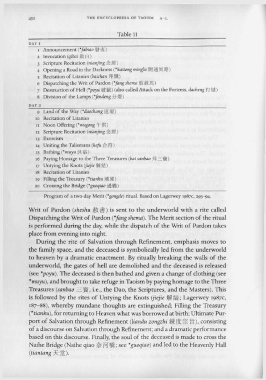Page 490 - The Encyclopedia of Taoism v1_A-L
P. 490
450 THB BNCYCLOPBDIA OF TAOISM A-L
Table 11
DAY I
1 Announcement (*fabiao 1ft 1k)
2 Invocation (qibai i& B)
3 Scripture Recitation (nianjing ~~)
4 Opening a Road in the Darkness (*kaitong minglli Im:iill ~,ijf)
5 Recitation of Litanies (baichan 1'HI)
6 Dispatching the Writ of Pardon (*fal1g shema fi;:1i1J:.Ji!§)
7 Destruction of Hell (*poyu li'!i~) (also called Attack on the Portress, dacheng tr.iJlX)
8 Division of the Lamps (*fendeng :0-:1:1)
DA Y 2
9 Land of the Way (*daochang ~~)
IQ Recitation of Litanies
n Noon Offering (*wugol1g 'F-#t)
12 Scripture Recitation (nialying ~~)
13 Exorcism
14 Uniting the Talismans (hefo if ~)
15 Bathing (*mliyli t,t:;nn
r6 Paying Homage to the Three Treasures (bai sanbao 'ff::::
17 Untying the Knots (jiejie fII~~)
18 Recitation of Litanies
19 Filling the Treasury (*tiankli :g'j;Jllf)
20 Crossing the Bridge (*guoqiao ilfHW)
Program of a two-day Merit (*gongde) ritual. Based on Lagerwey 1987C, 293-94.
Writ of Pardon (sheshu ~.) is sent to the underworld with a rite called
Dispatching the Writ of Pardon (*fang shema). The Merit section of the ritual
is performed during the day, while the dispatch of the Writ of Pardon takes
place from evening into night.
During the rite of Salvation through Refinement, emphasis moves to
the family space, and the deceased is symbolically led from the underworld
to heaven by a dramatic enactment. By ritually breaking the walls of the
underworld, the gates of hell are demolished and the deceased is released
(see *poyu). The deceased is then bathed and given a change of clothing (see
*muyu), and brought to take refuge in Taoism by paying homage to the Three
Treasures (sanbao = ~ , i.e., the Dao, the Scriptures, and the Masters). This
is followed by the rites of Untying the Knots (jiejie M ~ ; Lagerwey 1987C,
187-88), whereby mundane thoughts are extinguished; Filling the Treasury
(*tianku), for returning to Heaven what was borrowed at birth; Ultimate Pur-
port of Salvation through Refinement (liandu zongzhi i*1l* §'), consisting
of a discourse on Salvation through Refinement; and a dramatic performance
based on this discourse. Finally, the soul of the deceased is made to cross the
Naihe Bridge (Naihe qiao ~:('iiJ;jf,iJ ; see *guoqiao) and led to the Heavenly Hall
(tiantang 7C¥:).

